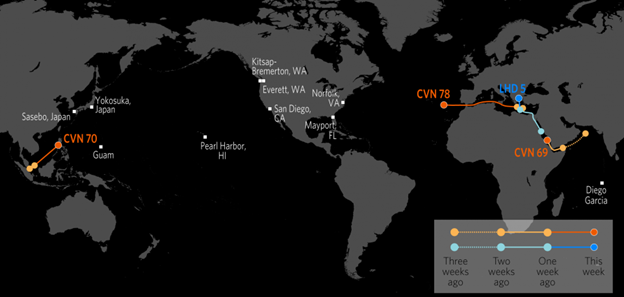The Daily Escape:

Barn in orchard with Mt. Hood in background, OR – January 2024 photo by Mitch Schreiber Photography
What are we to make of the continuing war in the Red Sea? The Iranian-backed Houthis launched more attacks on merchant shipping just hours after the US preemptively struck them in Yemen. There is word from unreliable sources that the Houthis have now banned all US and UK ships from transiting the Red Sea, an escalation. Previously, they focused only on maritime shipping associated with Israel.
From the WaPo:
“Just as global supply chains finally returned to normal….The continuing attacks by the Houthis…have increased global shipping costs, caused cargo carriers or their clients to opt for longer alternate routes from Asia to Europe and the United States and raised alarms about the economic costs of a wider conflict.”
More:
“Almost one-fifth of US freight arrives at East Coast ports after transiting the Red Sea and Suez Canal… Solar panels, electric vehicle batteries, toys and vacuum cleaners are among the goods making that trip. But for now, economists do not anticipate a major impact on the prices that US consumers pay — unless the violence worsens.”
Three months after the start of the Israel/Hamas war, a maritime danger zone has been created that extends hundreds of miles from its original location. Houthi militias have launched dozens of attacks on ships with drones and missiles, cutting container activity in the Suez canal by 90%.
The Western naval forces protecting global trade are now stretched dangerously thin. The attacks are beginning to spread beyond the Red Sea to the Gulf of Aden, which leads to the Arabian Sea and the Indian Ocean. That complicates the task facing US military planners.
The economic implications are easy to understand. What may be more difficult is what this implies for America’s preeminent role in defense of the seas. The US simply doesn’t have the armament or manpower to: a) occupy Yemen or b) push the Houthi back far enough from the mouth of the Red Sea to reopen the Suez Canal to western shipping.
We have to consider the implications of an important global logistic choke point being closed as retaliation for the Israel/Hamas war. Also a second choke point, the Panama Canal, has also been forced to limit ships due to their persistent drought.
A second strategic implication is the impact of drone warfare on naval operations. Drones are plentiful and cheap. Large numbers of cheap drones means that warships now must have enough anti-aircraft (AA) systems to stop drones, along with electronic warfare counter-measure systems. Otherwise, they become sitting ducks.
A new fact of war is that cheap drones will overwhelm expensive missiles.
Our navy’s defense against drone attacks on commercial vessels runs headlong into the fact that our ships at sea can only store so many missiles. The US has sent a number of AEGIS destroyers to help protect international shipping, performing the dual role of intercepting Houthi drone and missiles and coming to the aid of distressed commercial ships.
Every missile salvo reduces the amount of time before they have to be resupplied by returning to base. We also know that America’s manufacturing capacity for missiles is far below what is needed to refill stocks, given how many need to be expended against drone swarms in the Red Sea and elsewhere.
Here are a few numbers from Stephen Bryen:
“The [AEGIS] destroyers have a complement of 96 VLS cells, while the [Ticonderoga class] cruisers have 122…However, they need to fit a mixture of weaponry in those cells so they can’t all be used for air defense….In short, each of the AEGIS has around 100 missiles.”
More:
“Neither the US nor the British ships can be reprovisioned at sea, so they have a limited ability to “stay in the fight” if it continues for any length of time.”
So Yemen can launch a hundred drones and missiles at US ships and the destroyer escorts will very quickly exhaust their supply of air defense missiles. In the 1970s the U.S. Navy had ship tenders that could pull alongside a destroyer and resupply it. But today, these new Vertical Launch Systems must be reloaded in port.
In the ME, that means the destroyers will have to sail to Dubai or Europe, and the US aircraft carrier they are accompanying will have to follow because it relies on them for protection from ballistic and cruise missiles. Does America have enough carrier groups to rotate them when missile inventories are exhausted? The answer is no. Unless we are willing to move carrier groups from Asia to the ME. The US currently has 11 aircraft carriers in service, but here’s a map from Stratfor showing the location of our three! active carrier groups (CVNs) as of Jan 11, 2024:

We have three of 11 active, and you can see that CVN 78 (The Gerald Ford) sailed out of the Mediterranean and was replaced by CVN 69 (the Dwight Eisenhower) this week. This is the likely rotation for resupply of on-ship missiles.
Then there’s the issue of the US Navy’s manpower shortages. Forbes says in an article:
“…America’s newest aircraft carrier, the USS Gerald R. Ford (CVN-78), has downsized, cutting the crew aboard by hundreds of sailors….Over the past six months to a year, some 500 to 600 sailors have left the USS Ford and not been replaced.”
More:
“…most likely scenario, according to long-time Navy observers…is that, after the Navy’s massive 20% miss in FY 2023 enlisted sailor recruitment goals, the Navy simply has no sailors to spare.”
This is the US Navy that pretends it can take on either Russia or China or both together!
A profound shift is underway: Our globalized economy relies on ocean freight. Some 80% of trade by volume and 50% by value travels on a fleet of 105,000 container ships, tankers and freight vessels. But today’s superpower rivalry and the decay of global rules may mean that oceans will become a contested zone for the first time since the Cold War. China’s naval build-up means the US Navy’s primacy in the Pacific is being contested for the first time since 1945.
The “law of the sea” is in decline. China increasingly ignores rulings that it objects to. And the West’s use of sanctions has triggered a boom in smuggling: 10% of all tankers are part of a “dark fleet” operating outside mainstream laws and finance, more than twice as many as 18 months ago.
The bottom line is that the US cannot invade Yemen or stop the Yemenis from shooting missiles at commercial vessels or at our own warships. As always, we can bomb a lot, but that’s unlikely to stop the Yemenis. They live in a mountainous country and their missiles are mobile.
The US Navy can’t take them out just by bombing. The Yemenis are tough, experienced fighters. They have endured one of the longest and most brutal bombing campaigns of the last few decades, and they are still here.
The plain fact is that the US and its western allies simply do not have sufficient deterrence to prevail in the Red Sea. The shipping industry has already come to that conclusion:
“In response, some shipping companies have instructed vessels to instead sail around southern Africa, a slower and therefore more expensive route.”
Commercial cargo lines are not going to chance being shot up.
We don’t have sufficient deterrence to keep the Red Sea, and thereby, the Suez Canal, open. We can’t do enough to the Houthis to make them back down. And we won’t be able to stop them with boots on the ground.
What will the US military say is our way out of the box we’ve gotten ourselves into?

Belated happy 80th!
Re: “… the Panama Canal, has also been forced to limit ships due to their persistent drought.”
I’m an anti using they / their as personal singular pronoun. But canals aren’t persons. So it can be referred to as “its” rather than their. 😀
Re: “… the Panama Canal … has been forced to limit ships due to their persistent drought.”
I’d refer to “canal as “its” rather than their. (I won’t even use they/their for persons!) 😀
Belated happy 80th!
Wrongo, you lay out a compelling summary of the profound quandry our Nation – and the rest of the world – finds itself in with the Red Sea situation. We do have a choice with continuing the current situation or increasing our Armed response against Yemen and start hitting Iranian targets. We have avoided going after Houthi leadership…huge mistake. We need to make their lives as miserable as possible. Additionally, everyone knows Iran is behind these efforts…they also need to feel the pain which I believe should begin with sinking what little Navy they have.
Thomas Jefferson and James Madison took bold action over two hundred years ago in two Naval campaigns along the Barbary Coast, that set the precedence we should follow. They did so with a fledging Navy that like today, is relatively poorly equipped to meet the challenge. True leaders they were willing to take risks…sadly not emulated by the current occupant of the White House.